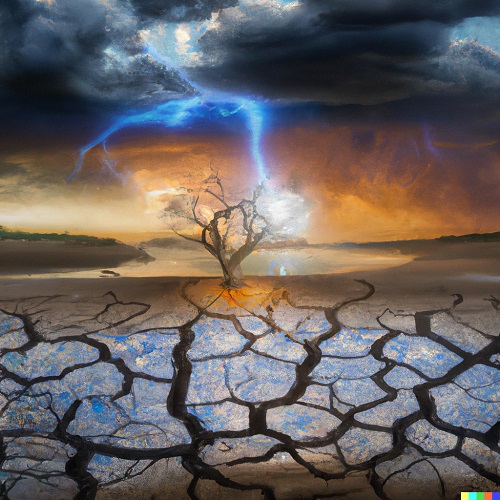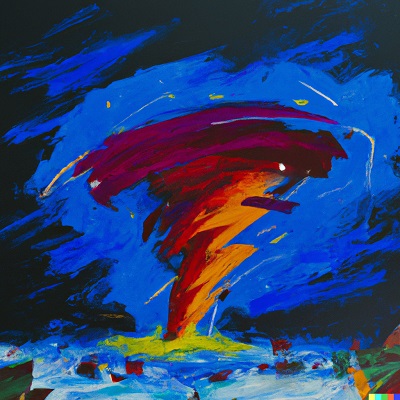
Climate change refers to the long-term warming of the Earth’s surface and atmosphere, largely caused by the increase in greenhouse gases resulting from human activities. One of the most significant impacts of climate change is the intensification of extreme weather events, such as heatwaves, droughts, floods, storms, hurricanes and more.
Here are extreme weather events that are impacted by climate change.
Heatwaves
Heatwaves are prolonged periods of extreme heat that can have serious health impacts, particularly for vulnerable populations such as the elderly, children, and those with underlying medical conditions. Climate change is contributing to the frequency and intensity of heatwaves by increasing the overall temperature of the Earth’s surface and atmosphere. As temperatures continue to rise, heatwaves are becoming more common and more severe, with record-breaking temperatures being observed in many parts of the world.
Droughts
Droughts are prolonged periods of below-average precipitation that can lead to water shortages and have serious impacts on agriculture, ecosystems, and human communities. Climate change is intensifying droughts by increasing the evaporation of water from the surface and decreasing the amount of rainfall in certain regions. As droughts become more frequent and severe, they can have significant consequences for food production, ecosystem health, and economic development.
Floods
Floods are events that occur when water overflows the normal boundaries of a river, stream, or other body of water, causing damage to property and infrastructure. Climate change is intensifying floods in several ways. Higher temperatures can lead to more water vapor in the air, resulting in heavier rainfall and more frequent flooding. Rising sea levels due to climate change can also increase the risk of coastal flooding, as higher water levels can lead to more widespread inundation. Additionally, the warming of the Arctic region can disrupt the jet stream, leading to more extreme and persistent weather patterns that can cause heavy rainfall and flooding in some areas.
Storms
Storms are meteorological events that involve the formation of thunderclouds and the accompanying precipitation, such as rain, hail, or snow. Climate change can affect the frequency and intensity of storms in several ways. For example, higher temperatures can lead to more water vapor in the air, which can increase the likelihood of heavy rainfall and thunderstorms. Warmer oceans can also provide more energy to fuel hurricanes, leading to more intense and destructive storms. Additionally, rising sea levels due to climate change can exacerbate the impact of coastal storms by increasing the amount of flooding and erosion.
Hurricanes
Hurricanes are large tropical cyclones that form over warm ocean waters and are characterized by strong winds, heavy rain, and high waves. Climate change can affect the frequency and intensity of hurricanes in several ways. Warmer sea surface temperatures can provide more energy to fuel hurricanes, leading to more intense and destructive storms. Rising sea levels due to climate change can also increase the risk of flooding and erosion caused by hurricanes. Additionally, the warming of the Arctic region can disrupt the jet stream, leading to changes in the path and intensity of hurricanes.
Blizzards
Blizzards are severe winter storms characterized by strong winds, low temperatures, and heavy snowfall. Climate change can impact blizzards by altering temperature patterns and the amount of moisture in the air. Warmer temperatures can result in more rain and less snow, while also leading to earlier snowmelt and shorter winters. However, climate change can also cause some regions to experience more extreme winter weather, including heavier snowfall and longer blizzards. This is because the warming of the Arctic region can disrupt the jet stream, leading to more frequent and severe cold air outbreaks in the mid-latitudes.
Wildfires
Climate change can increase the frequency and intensity of wildfires by creating drier and warmer conditions that are more conducive to fire. Higher temperatures and droughts can lead to more frequent and severe wildfires, which can have significant impacts on ecosystems, human communities, and the economy.
Tornadoes
Tornadoes are violent and destructive windstorms that can have serious impacts on human communities and infrastructure. Climate change may affect the frequency and intensity of tornadoes by altering temperature and humidity patterns, which can influence the formation of thunderstorms and other conditions that are conducive to tornadoes.

Hailstorms
Hailstones are balls of ice that form within thunderclouds and can cause damage to crops, buildings, and other structures. Climate change may affect the frequency and intensity of hailstorms by altering temperature and humidity patterns, which can influence the formation of thunderclouds and the size of hailstones.
Lightning
Lightning is a form of electricity that occurs during thunderstorms and can cause damage to buildings and infrastructure, as well as pose a risk to human safety. Climate change may affect the frequency and intensity of lightning by altering temperature and humidity patterns, which can influence the formation of thunderstorms.
Winter Storms
Winter storms are meteorological events that involve the formation of snow, ice, or other precipitation and can have serious impacts on transportation, agriculture, and human communities. Climate change may affect the frequency and intensity of winter storms by altering temperature patterns and the amount of moisture in the air, leading to more extreme and persistent weather patterns.
Heatstroke
Heatstroke is a severe form of heat illness that occurs when the body is unable to regulate its temperature, leading to a high body temperature and potentially serious health consequences. Climate change can increase the risk of heatstroke by increasing the frequency and intensity of heatwaves.
Cold Waves
Cold waves are prolonged periods of extreme cold that can have serious health impacts, particularly for vulnerable populations such as the elderly, children, and those with underlying medical conditions. Climate change may affect the frequency and intensity of cold waves by altering temperature patterns and the movement of cold air masses.
Fog
Fog is a meteorological phenomenon that occurs when the air is cooled to its dew point, leading to the formation of water droplets or ice crystals. Climate change may affect the frequency and intensity of fog by altering temperature and humidity patterns, which can influence the formation of fog.
Ice Storms
Ice storms are meteorological events that involve the formation of freezing rain or sleet, which can lead to the accumulation of ice on surfaces and cause damage to buildings and infrastructure. Climate change may affect the frequency and intensity of ice storms by altering temperature patterns and the amount of moisture in the air.

Dust storms
Dust storms are meteorological events that involve the transport of large amounts of dust and other particles through the air, which can cause visibility issues and have health impacts. Climate change may affect the frequency and intensity of dust storms by altering temperature and moisture patterns, which can influence the formation of dust storms.
Tsunamis
Tsunamis are large waves caused by earthquakes, volcanic eruptions, or landslides that can have serious impacts on coastal communities and ecosystems. Climate change may affect the frequency and intensity of tsunamis by altering sea levels and the risk of earthquakes, volcanic eruptions, and landslides.
It is important to note that the impacts of climate change on extreme weather events are complex and can vary depending on location and other factors. However, it is clear that climate change is having a significant impact on the frequency and intensity of extreme weather events, and that these impacts have the potential to cause significant damage to communities and ecosystems, as well as disrupt the economy and social systems. It is crucial that we take action to mitigate the causes of climate change and adapt to its impacts to reduce the risks to people and the environment.
In summary, climate change is intensifying extreme weather events, including heatwaves, droughts, floods, storms, hurricanes and more. These impacts have the potential to cause significant damage to communities and ecosystems, as well as disrupt the economy and social systems. It is crucial that we take action to mitigate the causes of climate change and adapt to its impacts to reduce the risks to people and the environment.
This essay was created by ChatGPT and the images by DALL-E 2. Edited by Omri Shabath.



